I've been getting my butt kicked trying to get a vertically placed 3d model GLB format placed properly on a vertical surface.
Just to be clear, I am not referring to the difficulty of identifying vertical surface, that is a whole other problem in itself.
Removing common boilerplate of setup to minimize this post.
I am using a fragment that extends ARFragment.
class SceneFormARFragment: ArFragment() {
Then of course I have supplied the config with a few tweaks.
override fun getSessionConfiguration(session: Session?): Config {
val config = super.getSessionConfiguration(session)
// By default we are not tracking and tracking is driven by startTracking()
config.planeFindingMode = Config.PlaneFindingMode.DISABLED
config.focusMode = Config.FocusMode.AUTO
return config
}
And to start and stop my AR experience I wrote a couple of methods inside the fragment as follows.
private fun startTracking() = viewScope.launchWhenResumed {
try {
arSceneView.session?.apply {
val changedConfig = config
changedConfig.planeFindingMode = Config.PlaneFindingMode.HORIZONTAL_AND_VERTICAL
configure(changedConfig)
}
logv("startTracking")
planeDiscoveryController.show()
arSceneView.planeRenderer.isVisible = true
arSceneView.cameraStreamRenderPriority = 7
} catch (ex: Exception) {
loge("error starting ar session: ${ex.message}")
}
}
private fun stopTracking() = viewScope.launchWhenResumed {
try {
arSceneView.session?.apply {
val changedConfig = config
changedConfig.planeFindingMode = Config.PlaneFindingMode.DISABLED
configure(changedConfig)
}
logv("stopTracking")
planeDiscoveryController.hide()
arSceneView.planeRenderer.isVisible = false
arSceneView.cameraStreamRenderPriority = 0
} catch (ex: Exception) {
loge("error stopping ar session: ${ex.message}")
}
}
In case you are wondering the reason for "starting and stopping" the AR experience is to maximize the GPU cycles for other UX interactions that are heavy on this overlaid screen, so we wait to start or stop based on current live data state of other things that are happening.
Ok moving on.
Let's review the HitResult handling: In this method I do a few things:
- Load two variations of TV 3d models from the cloud (wall mount and stand mount)
- I remove any active models if they have tapped a new area
- Create an anchor node from the hitresult and assign it a name to remove it later
- Add a TVTransformableNode to it and assign it a name to retrieve and manipulate it later
- Determine the look direction of the horizontal stand mount 3D Model TV and set the worldRotation of the anchorNode to the new lookRotation. (NOTE*, I feel like the rotation should be applied to the TVNode, but it only seems to work when I apply it to the AnchorNode for whatever reason.) This camera position math also seems to help the vertical wall mount TV face outwards and anchor correctly. (I have reviewed the GLB models and I know they are properly anchored from the back on the wall model and from the bottom on the floor model)
- I then limit the plane movement of the node to it's own respective plane type so that a floor model doesn't slide up to a wall and so that a wall model doesn't slide down to the floor.
That's about it. The horizontal placement works great, but the vertical placement is always randomized.
OnTapArPlane Code below:
private fun onARSurfaceTapped() {
setOnTapArPlaneListener { hitResult, plane, _ ->
var isHorizontal = false
val renderable = when (plane.type) {
Plane.Type.HORIZONTAL_UPWARD_FACING -> {
isHorizontal = true
standmountTVRenderable
}
Plane.Type.VERTICAL -> wallmountTVRenderable
else -> {
activity?.toast("Do you want it to fall on your head really?")
return@setOnTapArPlaneListener
}
}
lastSelectedPlaneOrientation = plane.type
removeActive3DTVModel()
val anchorNode = AnchorNode(hitResult.createAnchor())
anchorNode.name = TV_ANCHOR_NAME
anchorNode.setParent(arSceneView.scene)
val tvNode = TransformableNode(this.transformationSystem)
tvNode.scaleController.isEnabled = false
tvNode.setParent(anchorNode)
tvNode.name = TV_NODE_NAME
tvNode.select()
// Set orientation towards camera
// Ref: https://github.com/google-ar/sceneform-android-sdk/issues/379
val cameraPosition = arSceneView.scene.camera.worldPosition
val tvPosition = anchorNode.worldPosition
val direction = Vector3.subtract(cameraPosition, tvPosition)
if(isHorizontal) {
tvNode.translationController.allowedPlaneTypes.clear()
tvNode.translationController.allowedPlaneTypes.add(Plane.Type.HORIZONTAL_UPWARD_FACING)
} else {
tvNode.translationController.allowedPlaneTypes.clear()
tvNode.translationController.allowedPlaneTypes.add(Plane.Type.VERTICAL)
}
val lookRotation = Quaternion.lookRotation(direction, Vector3.up())
anchorNode.worldRotation = lookRotation
tvNode.renderable = renderable
addVideoTo3DModel(renderable)
}
}
Ignore the addvideoTo3dModel call, as that works fine, and I commented it out just to ensure it doesn't play a role.
Things I've tried.
- Extracting Translation without Rotation like described here interestingly enough, it does cause the TV to appear level with the floor each time, but then the TV is always mounted as if the anchor is at the base instead of the center back. So it's bad.
- I've tried reviewing various posts and translating Unity or ARCore stuff directly into Sceneform, but failed to get anything to affect the outcome. example
- I've tried creating the anchor from the plane and the pose as indicated in this answer with no luck
- I've reviewed this link but never found anything useful
- I've tracked this issue and tried solutions recommended by people in the thread, but no luck
- The last thing I tried, and this is a bit embarrassing lol. I opened all 256 tagged with "SceneForm" in Stack Overflow and reviewed EVERY SINGLE one of them for anything that would help.
So I've exhausted the internet. All I have left is to ask the community and of course send help to SceneForm team at Android which I'm also going to do.
My best guess is that I need to do the Quaternion.axisRotation(Vector3, Float), but everything I have guessed at or trialed and errored has not worked. I assume I need to set the localRotation using worldPostion values for xyz of the phone maybe to help identify gravity. I really just don't know anymore lol.
I know Sceneform is pretty new and the documentation is HORRIBLE and may as well not exist with the lack of content or doc headers on it. The developers must really not want people to use it yet I'm guessing :(.
Last thing I'll say, is everything is working perfectly in my current implementation with the exception of the rotated vertical placement. Just to avoid rabbit trails on this discussion, I'm not having any other issues.
Oh and one last clue that I've noticed. The TV almost seems to pivot around the center of the vertical plane, based on where I tap, the bottom almost seems to point towards the arbitrary center of the plane, if that helps anyone figure it out.
Oh and yes, I know my textures are missing from the GLBs, I packaged them incorrectly and intend to fix it later.


